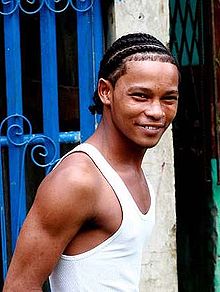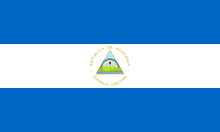Nicaraguans
Roman Catholic and Protestant; irreligious and other religious minorities exist[2] | |
| Related ethnic groups | |
|---|---|
Nicaraguans (Spanish: Nicaragüenses; also called Nicas) are people inhabiting in, originating or having significant heritage from Nicaragua. Most Nicaraguans live in Nicaragua, although there is also a significant Nicaraguan diaspora, particularly in Costa Rica and the United States with smaller communities in other countries around the world. There are also people living in Nicaragua who are not Nicaraguans because they were not born or raised in Nicaragua nor have they gained citizenship.
Demographics
Population

As of 2023, Nicaragua's total human population reached 7.0 million, with the capital (and most populous) city of Managua containing 1.5 million.
According to the
| Ethnic groups | |
|---|---|
| Group | Number |
| Mestizo (41%) | 3,158,328 |
| White (17%) | 1,670,557 |
| Black (9%) | 567,777 |
| Indigenous (33%) | 2,283,888 |
| Source: CIA World Factbook (2007) | |
Ethnic groups
Data from the
About 5% of Nicaraguans are descending from one or more of the country's indigenous peoples. Nicaragua's
The remainder 9% of Nicaragua's population is black, and mainly reside on the country's sparsely populated Caribbean (or Atlantic) coast. The black population is mostly of
Immigration

Relative to its overall population, Nicaragua has never experienced any large scale wave of

In the 19th century Nicaragua experienced a wave of immigration, primarily from Europe. In particular, families from Spain, Germany, Italy, France and Belgium generally moved to Nicaragua to start a new life. They received free land, monetary incentives, and other perks in exchange for populating unsettled territories and working in the new growing coffee industry. In time immigrants were able to set up newspapers, hotels and banks.
There is also a small
Nicaraguans abroad
Nicaragua, as well as other Latin American countries, have a long history of migration to the United States. However, Nicaragua is the only country in its region to have Costa Rica as the primary destination. Estimates on the basis of the Nicaraguan Health Survey indicated that at least 11% of Nicaraguan households have at least 1 person residing abroad.[4]
Smaller numbers of Nicaraguans live in many other countries around the world such as other countries in
Nicaraguans in Costa Rica
Nicaraguan migration to Costa Rica has occurred since the mid-19th century. Unlike other Latin American countries, Nicaraguan migrants' primary destination is not the United States, it is Costa Rica. An estimate 9% (more than 385,899) of the Costa Rican population is made up of Nicaraguans;[5] some of them migrate for seasonal work opportunities and then return to their country. Costa Rica and Nicaragua signed an agreement regulating seasonal migration in 1998; it allows Nicaraguans with work permits to enter Costa Rica at the western border at Peñas Blancas on the Pan-American Highway. In the northern part of Costa Rica there are 287,766 Nicaraguans and the Catholic Church in this area has an active program to protect the rights of migrant workers.[6]
Nicaraguans in the United States

Abroad, the United States is home to the second largest number of Nicaraguans outside Nicaragua, particularly in the
The earliest documents of immigration from Nicaragua to the United States was combined in total with those of other
According to the
- Areas of greatest concentration in the United States
The largest concentration of Nicaraguan Americans in the United States, about 79,559, is in Miami, Florida, most notably around the areas of Sweetwater and "Little Managua". Sweetwater has the highest concentration of Nicaraguan American in the United States, in 2000 16.63% of Sweetwater residents identified as being of Nicaraguan heritage. This was the highest percentage of Nicaraguan Americans of any place in the country. As a result, Sweetwater is locally known as "Little Managua" after Managua, the Nicaraguan capital. However, the area of "Little Havana" in Miami is also colloquially called "Little Managua" even though Sweetwater has a higher number of Nicaraguan Americans.
History

It is known that Nicaragua was inhabited by
During the 1979 uprising, many middle-class and wealthy families left Nicaragua. The
Many Nicaraguans who immigrated did so to escape poverty, in
Culture and traditions

El Güegüense is a satirical drama and was the first literary work of pre-Columbian Nicaragua. It is regarded as one of Latin America's most distinctive colonial-era expressions and as Nicaragua's signature folkloric masterpiece combining music, dance and theater.[18] The theatrical play was written by an anonymous author in the 16th century, making it one of the oldest indigenous theatrical/dance works of the Western Hemisphere.[19] The story was published in a book in 1942 after many centuries.[20]
Language


Spanish is spoken by about 90% of the country's population. In Nicaragua the
The language and pronunciation varies depending on region. Some Nicaraguans pronounce the word vos with a strong s sound at the end. In the central part of the country, regions like Boaco pronounce vos without the s sound at the end. The result is vo, similar to vous in French and voi in Italian.
Nicaragua has a total of 4
Symbols

The flag of Nicaragua was adopted on August 27, 1971. It is based on the flag of the United States of Central America. The two blue stripes represented the Pacific Ocean and Atlantic Ocean; while white symbolizes peace. A modern interpretation indicates that the color blue symbolizes justice and loyalty; while the color white represents virtue and purity. The coat of arms features an equilateral triangle which represents equality. Inside the triangle are five volcanoes, which represent the five members of the federation. The triangle also contains symbols of liberty and peace which is represented by a red Phrygian cap, white rays and a rainbow.
See also
References
- ^ a b c d e f g h i j k l m n o p q r s t u v w x y z aa ab ac ad "Nicaragua - Emigrantes totales". expansion.com/ Datosmacro.com (in Spanish).
- ^ The Latin American Socio-Religious Studies Program / Programa Latinoamericano de Estudios Sociorreligiosos (PROLADES) PROLADES Religion in America by country
- ^ "VIII Censo de Poblacion y IV de Vivienda" (PDF). Instituto Nacional de Estadística y Censos (in Spanish). October 2005. Archived from the original (PDF) on 2007-08-24. Retrieved 2007-07-07.
- ^ Vargas, Juan Carlos. "Nicaraguans in Costa Rica and the United States: Data from Ethnic Surveys". California Center for Population Research. Retrieved 2007-10-02.
- ^ "Background Note: Costa Rica; People". U.S. State Department. Retrieved 2007-10-02.
- ^ "Best Practices Concerning Migrant Workers and their Families" (PDF). UNESCO. Retrieved 2007-10-02.
- ^ "2005 American Community Survey". U.S. Census Bureau, 2006. Retrieved 2007-10-02.
- ^ Orlov, Ann; Reed Veda (1980). "Central and South Americans," Harvard Encyclopedia of American Ethnic Groups. Harvard University Press. pp. 210–217.
- ^ a b "Context for Nicaraguan Immigration". Archived from the original on 2007-05-20. Retrieved 2007-05-24.
- ^ "1990 U.S. Census". U.S. Census Bureau. 1990. Retrieved 2007-05-24.
- ^ a b Funkhouser, Edward (1992). Migration from Nicaragua: Some Recent Evidence. p. 1210.
{{cite book}}:|work=ignored (help) - ^ "Census 2000 Demographic Profile Highlights: Nicaraguans". U.S. Census Bureau. 2000. Retrieved 2007-05-24.[permanent dead link]
- ^ "Nicaragua: VI History". Encarta. Archived from the original on 2009-10-29. Retrieved 2007-06-13.
- ISBN 0520060490.
- ^ H. Lundquist, Jennifer; Douglas S. Massey (2005). The Contra War and Nicaraguan Migration to the United States. pp. 29–53.
{{cite book}}:|work=ignored (help) - ISBN 0-415-91768-9.
- ^ Warantz 1983, p. 71.
- ^ a b "Showcasing Nicaragua's Folkloric Masterpiece - El Gueguense - and Other Performing and Visual Arts". Encyclopedia.com. Retrieved 2007-08-03.
- ^ "Native Theatre: El Gueguense". Smithsonian Institution. Archived from the original on 2007-12-06. Retrieved 2007-08-03.
- ^ "El Güegüense o Macho Ratón". ViaNica. Retrieved 2007-08-03.
- ^ "Languages of Nicaragua". Ethnologue. Retrieved 2007-05-09.
- ^ "Colegio Aleman Nicaraguense".
Warantz, Elissa (1983). "The Bay Islands English of Honduras". In
